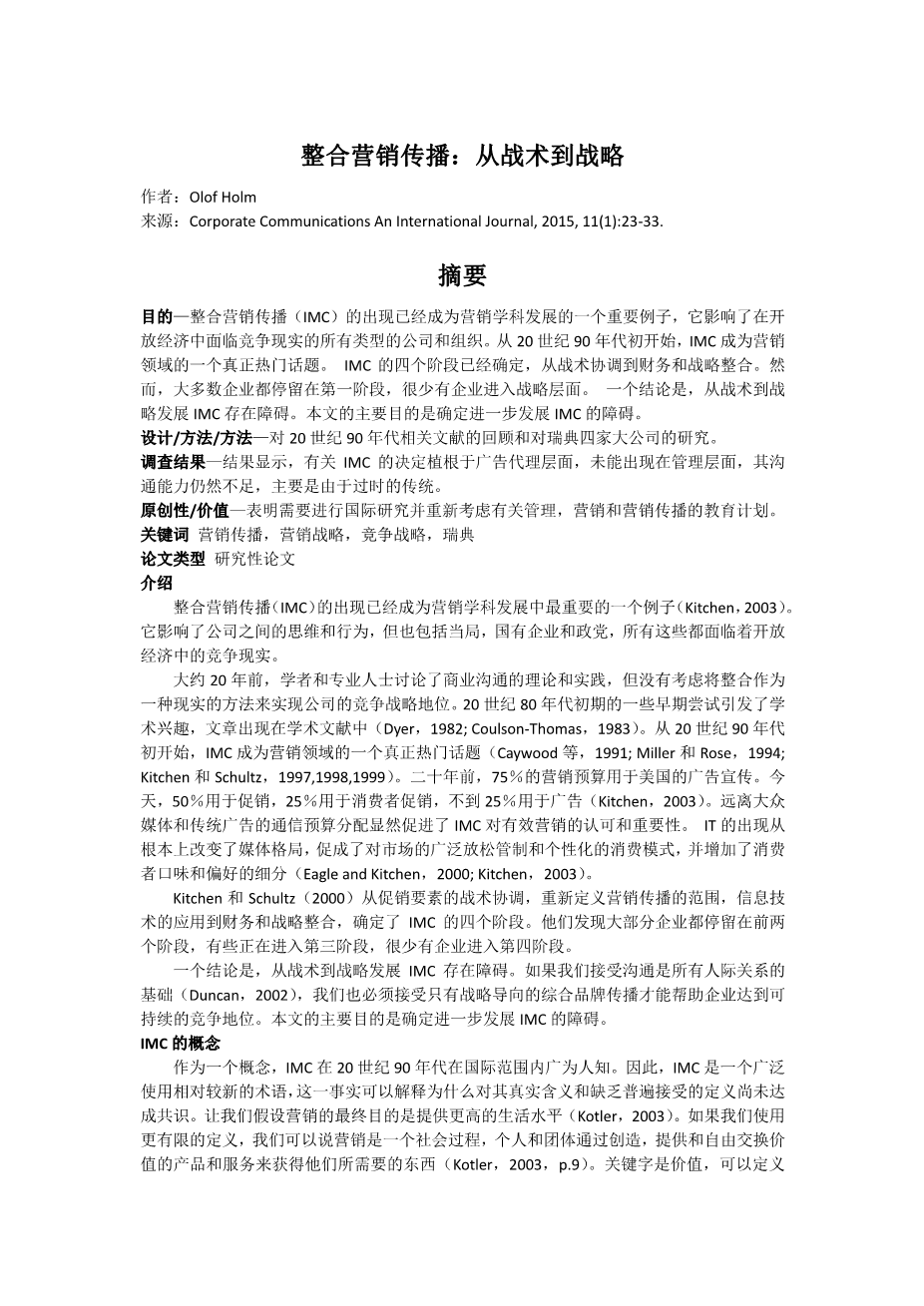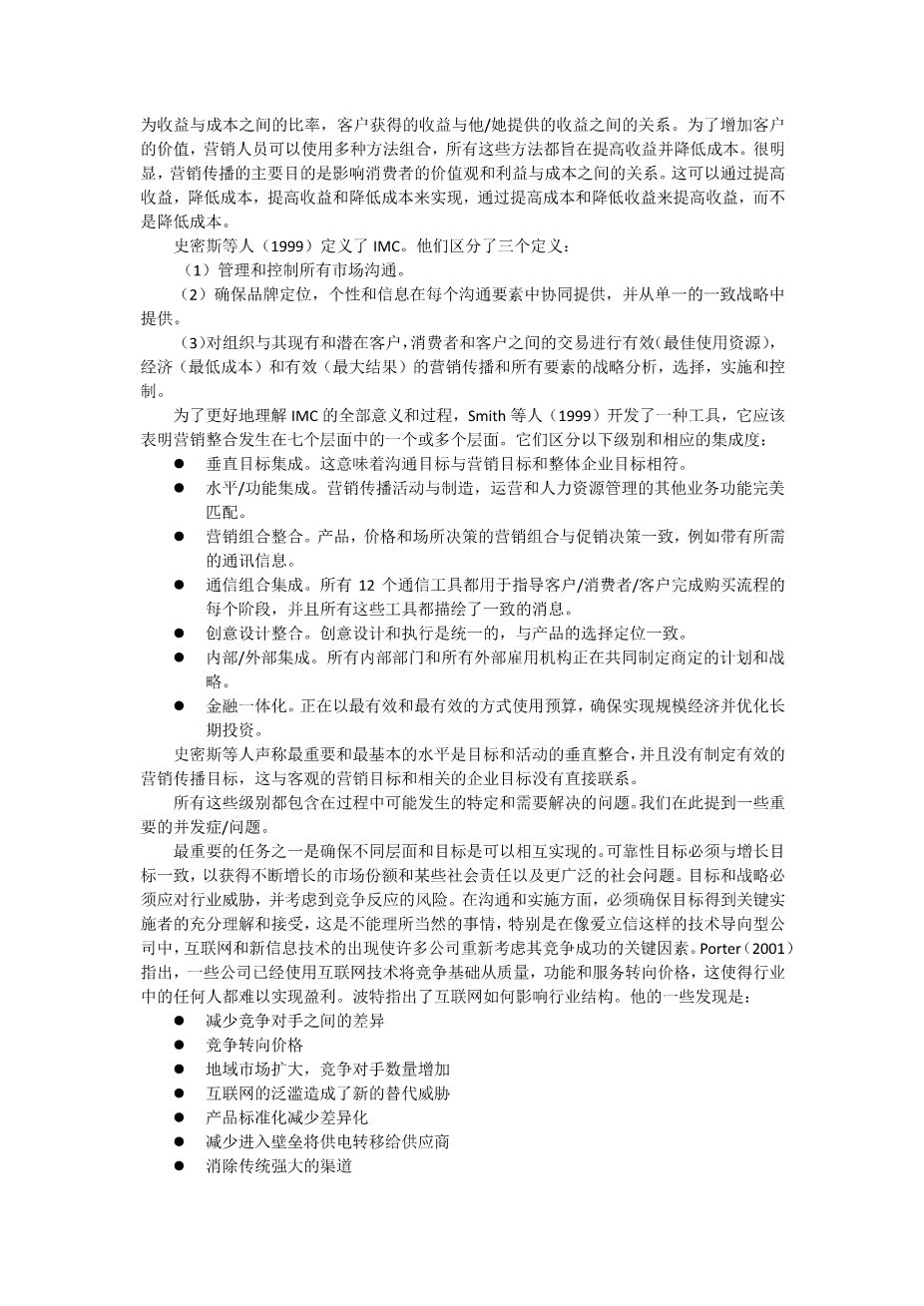Integrated marketing communication: from tactics to strategy
作者:Olof Holm
来源:Corporate Communications An International Journal, 2015, 11(1):23-33.
Abstract
Purpose – The emergence of integrated marketing communications (IMC) has become a significant example of development in the marketing discipline. It has influenced thinking and acting among all types of companies and organizations facing the realities of competition in an open economy. From the beginning of the 1990s IMC became a real hot topic in the field of marketing. Four stages of IMC have been identified, starting from tactical coordination to financial and strategic integration. However, the majority of firms are anchored in the first stages and very few have moved to a strategic level. One conclusion is that there are barriers to developing IMC from tactics to strategy. The main purpose of this paper is to identify obstacles to further developing IMC.
Design/methodology/approach – A review of relevant literature during the 1990s and a study of four large Swedish companies.
Findings – Results show that decisions concerning IMC are rooted on the advertising agency level and have failed to appear on management level, whose communicative ability has remained insufficient, mainly due to obsolete tradition.
Originality/value – Indicates a need for international research and a reconsideration of educational programs regarding management, marketing and marketing communications. Keywords Marketing communications, Marketing strategy, Competitive strategy, Sweden
Paper type Research paper
Introduction
The emergence of integrated marketing communications (IMC) has become one of the most significant example of development in the marketing discipline (Kitchen, 2003). It has influenced thinking and acting among companies but also authorities, state owned companies and political parties, all facing the realities of competition in an open economy.
Some 20 years ago academics and professionals discussed theory and practice of business communication but without considering the idea of integration as a realistic approach to reach a competitive strategic position for the company. Some early attempts in the beginning of the 1980s initiated academic interest and articles appeared in the academic literature (Dyer, 1982; Coulson-Thomas, 1983). From the beginning of the 1990s IMC became a real hot topic in the field of marketing (Caywood et al., 1991; Miller and Rose, 1994; Kitchen and Schultz, 1997, 1998, 1999). Twenty years ago, 75 percent of marketing budgets went to advertising in the US. Today, 50 percent goes into trade promotions, 25 percent into consumer promotions and less than 25 percent into advertising (Kitchen, 2003). The allocation of communication budgets away from mass media and traditional advertising has obviously promoted IMC in recognition and importance for effective marketing. The emergence of IT has fundamentally changed the media landscape, contributed to an extensive deregulation of markets and individualized patterns of consumption and increased the segmentation of consumer tastes and preferences (Eagle and Kitchen, 2000; Kitchen, 2003).
Kitchen and Schultz (2000) have identified four stages of IMC starting from tactical coordination of promotional elements, redefining the scope of marketing communications, application of information technology to financial and strategic integration. They found that the majority of firms are anchored in the first two stages, some are moving into stage three and very few have moved to stage four.
One conclusion is that there are barriers to developing IMC from tactics to strategy. If we accept that communication is the foundation of all human relationship (Duncan, 2002) we also have to accept that only strategically oriented integrated brand communications can help business to reach a sustainable competitive position. The main purpose of this paper is to identify obstacles to further developing IMC.
The concept of IMC
As a concept IMC has become well known on an international scale during the 1990s. Thus IMC is a term whose widespread use is comparatively recent, a fact, which might explain why there not yet is a common understanding of its real meaning and the lack of a generally accepted definition. Let us assume that the ultimate purpose of marketing is to deliver a higher standard of living (Kotler, 2003). If we use a more limited definition we could say that marketing is a societal process by which individuals and groups obtain what they need and want through creating, offering and freely exchanging products and services of value with others (Kotler, 2003, p. 9). The keyword is value, which can be defined as a ratio between benefits and costs, between what the customer gets and what he/she gives. To increase the value of the customer offering the marketer can use several combinations of methods, all aiming to raise benefits and reduce costs. It is then evident that the main purpose of marketing communication is to affect the consumer’s conception of value and of the relation between benefits and costs. This can be achieved by raising benefits, reducing costs, raising benefits and reducing costs, raising benefits by more than the raise in costs and lower benefits by less than the reduction in costs.
Smith et al. (1999) have defined IMC. They distinguish three definitions:
(1) Management and control of all market communications.
(2)Ensuring that the brand positioning, personality and messages are delivered synergistically across every element of communication and are delivered from a single consistent strategy.
(3) The strategic analysis, choice, implementation and control of all elements of marketing communications which efficiently (best use
剩余内容已隐藏,支付完成后下载完整资料


英语译文共 7 页,剩余内容已隐藏,支付完成后下载完整资料
资料编号:[438736],资料为PDF文档或Word文档,PDF文档可免费转换为Word
以上是毕业论文外文翻译,课题毕业论文、任务书、文献综述、开题报告、程序设计、图纸设计等资料可联系客服协助查找。


